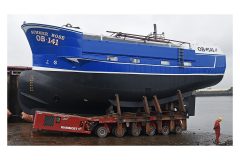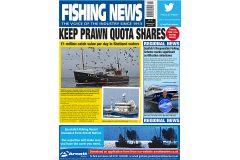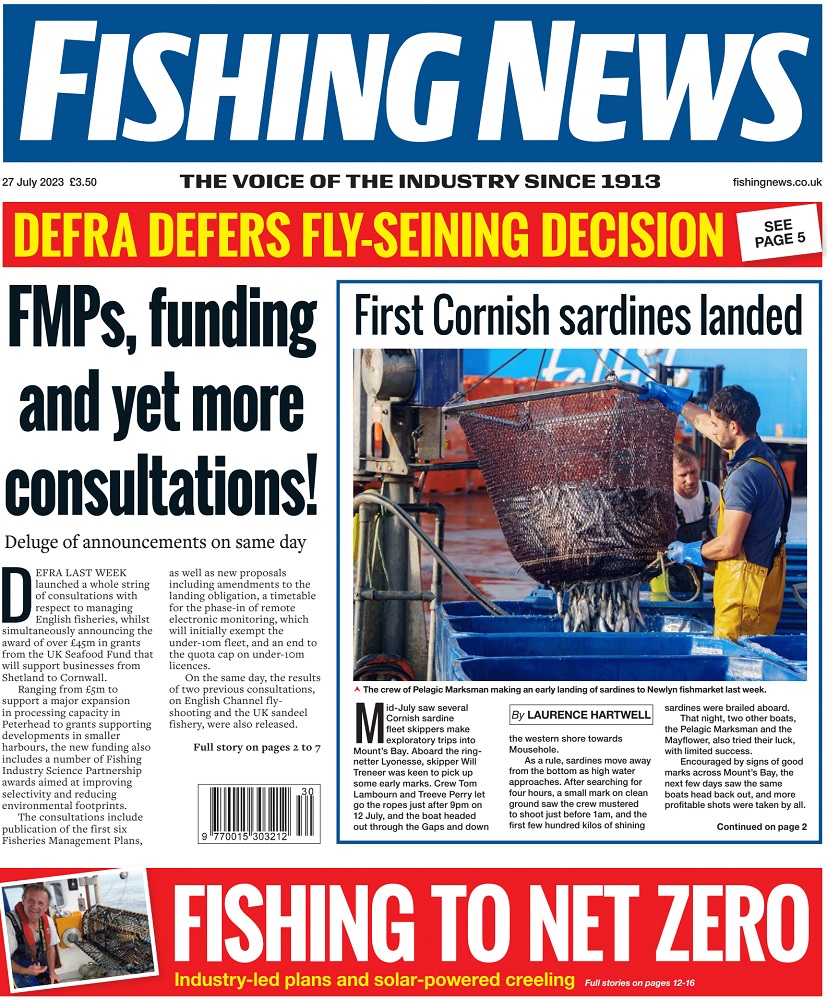Trawl and creel sectors both competitive says major study.
A major study has concluded that prawn trawlers in Scotland are just as competitive as the creel fleet, undermining the case for a major transfer of quota, reports Tim Oliver.
It also said the outlook for the Scottish prawn sector is positive, and there is investment in both the fleet and onshore sector.
The study was commissioned by the Scottish Fishermen’s Federation (SFF) and Scottish Fishermen’s Organisation (SFO) in response to a call from the Scottish Creel Fishermen’s Federation (SCFF) for the Scottish government to give Scotland’s creel fishermen a 50% share of the Nephrops fishery by 2022, to enable them to supply the growing live langoustine market (Fishing News, 22 June, ‘Scots prawn gear split’).
The call was based on a 35-page study carried out for the SCFF, which said that Scotland’s Nephrops fishery has the potential to create over 700 new local jobs and contribute an additional £45m annually to coastal communities.
Now, economic development consultancy Anderson Solutions has conducted a comprehensive analysis of Scotland’s £80m Nephrops sector – the biggest in the world – examining quota, weight and value of landings, employment and supply chains.
It concluded in a 91-page report: “The competitiveness of the different fleet segments in Scotland is relatively well-balanced.”
Bertie Armstrong, chief executive of the SFF, said: “The creel sector’s argument amounted to a call for a perfectly sustainable and profitable sector to be shut down, which is ridiculous.
“Part of the rationale seemed to be that this would create more than 700 new jobs. This study is clear that there are 1,588 full-time equivalent posts in the trawl sector, to 489 in the creel sector, so the net effect would be the loss of 900 jobs.”
John Anderson, chief executive of the SFO, said: “We commissioned this work to investigate what we perceived to be a deeply flawed, but headline-grabbing, proposition that half of the Scottish Nephrops quota currently held by mobile gears should be re-allocated to static gears to improve the overall socio-economic performance of the Nephrops sector in Scotland.
“This extremely comprehensive assessment confirms that there is no real economic rationale for re-allocation between gear types; rather, it quite clearly demonstrates that not only are the mobile- and static-gear fleets remarkably similar in terms of overall competitiveness, they also have distinct but equally important roles to play in contributing to the economic resilience of our coastal communities, and in maintaining Scotland’s position as the world’s leading producer of high-quality langoustine.”
People consulted during the research for the report said that comparing the prawn trawl and creel sectors was like ‘comparing apples with pears’. They use different gear, face different regulations, produce different volumes of product, achieve different prices and, on the whole, produce different products for different markets.
But the report concludes: “The analysis of competitiveness has shown that while different businesses do make different decisions, there is remarkable similarity in the competitiveness of the larger creel vessels and the trawl fleet segments.”
The report stresses the diversity of the Scottish Nephrops fleet in terms of gear, size of vessels, grounds fished, and markets supplied. But, because of the high demand for finite Nephrops grounds and quota, this diversity can be a source of conflict.
“Competition for space in West of Scotland Nephrops grounds is a concern for all owners of West of Scotland Nephrops vessels,” says the report. But ‘access to quota does not appear to be a constraint for the Scottish Nephrops fleet’.
Landings
The report details the differences between the trawl and creel, and North Sea and West of Scotland prawn fisheries.
In 2015, 15,224t of Nephrops was landed in Scotland from the North Sea and West of Scotland. Of this, 1,431t (9.4%) was landed by creel vessels and 13,793t (90.6%) by trawl vessels.
Almost all creel landings – 1,369t (95.7%) – were West of Scotland Nephrops. Of all North Sea trawl landings, 3,277t (67.7%) was landed whole and 1,564t (32.3%) as tails.
Of all West of Scotland trawl landings, 3,619t (40.4%) were landed whole and 5,334t (59.6%) as tails, while 1,410t (98.5%) of all creel landings from West of Scotland and the North Sea Nephrops were landed whole.
In 2015, total landings were worth £55.8m. Of this, £13m was landed by the creel sector and £42.8m by trawlers. There is a higher proportion of tails landed on the west coast, which results in a lower share of the total value compared to weight of landings.
Competitiveness
The findings explain why Scotland has such a diverse Nephrops fleet, and suggest that the competitiveness of the different fleet segments in Scotland is relatively well-balanced.
“The only fleet segment that appears to underperform in the competitiveness analysis is the under-10m West of Scotland creel fleet,” says the report. ‘The most effective way to improve the competitiveness of the under-10m creel fleet would be to reduce the cost base relative to income, and therefore improve economy.”
The Scottish Creel Fishermen’s Federation said it was considering the report and their response will be in next week’s issue of Fishing News.
Future outlook ‘positive’
The report says current activity and estimates of economic performance for 2016 suggest the economic performance of the fleet is improving after a period of relative weakness.
“There are encouraging signs of business confidence both within the fleet, with the purchase of new-build vessels and new gear, and onshore, with investment in the development of new products and markets.”
But clouds on the horizon include:
- uncertainty around Brexit and its potential impact on fuel prices and key European markets for Nephrops
- competition for fishing grounds ‘is a persistent and real concern – comments such as creel saturation and gear conflict frequently cropped up in consultations’. The problem is greatest in the West of Scotland, where competition can arise within a fleet segment, between different Nephrops fleet segments, and with other fleets and marine users. ‘It appears that management solutions are required to address this challenge’.
Trawlers will need to become more selective in response to the landing obligation. There are also concerns in the West of Scotland trawl fleets and the onshore sector that more grounds could be closed to trawlers, for example through MPAs.
“The effect of these restrictions on the decisions of business owners is not yet known. However, a displacement effect is likely. The challenge is for the regional inshore fisheries groups and the Scottish government to find a way to ensure the continued productivity of all Nephrops fleets.”
The overall view from those consulted was that while there are challenges, ‘there is much to be positive about in the Nephrops industry in Scotland’.
The full report can be read here.






